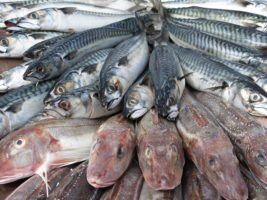

Environment
North American Fish Stocks Are Affected by Climate Change
Four new studies report that climate change is affecting inland fish – including some species which are popular with anglers – across North America. The studies show an impact on reproduction, growth and habitat.
“Thanks to this synthesis, we can see the effects of climate change on inland fish are no longer just future speculation, but today’s facts, with real economic, social, and ecological impacts,” said Doug Austen, Executive Director of the American Fisheries Society and Publisher of Fisheries magazine. “Now that trends are being revealed, we can start to tease apart the various stressors on inland fish and invest in conservation and research where these programs will really make a difference in both the short and long term.”
The authors reviewed 31 studies across North America and Canada that document fish responses to climate change. The manuscripts describe the impacts of climate change to individual fish, populations, recreational fishers, and fisheries managers. One of the takeaway messages is that climate change effects on fish are rarely straightforward, and they affect warm water and cold water fish differently.
The authors emphasise that resource managers can take many actions to help sustain resilient fish communities and fisheries. “Even though climate change can seem overwhelming, fisheries managers have the tools to develop adaptation strategies to conserve and maintain fish populations,” said Craig Paukert, a lead author and fisheries scientist at the USGS Missouri Cooperative Fish and Wildlife Research Unit at the University of Missouri.
“The current state of the science shows that climate change is impacting fish in lakes, rivers, and streams, but knowing that is just the first step in effectively addressing the changes to these important natural resources and the communities which depend upon them,” said Abigail Lynch, a lead author with the USGS National Climate Change and Wildlife Science Center.
Other major findings:
- Climate change may be altering abundance and growth of some North American inland fishes, particularly cold water fish such as Sockeye Salmon, a species experiencing well-documented shifts in range, abundance, migration, growth, and reproduction.
- Climate change may be causing earlier migration timing and allowing species that never occurred together previously to hybridise. For example, native Westslope Cutthroat Trout in the Rocky Mountains are now hybridising with Rainbow Trout, a non-native species.
- Shifts in species’ ranges are already changing the kinds of fish in a specific water body, resulting in new species interactions and altered predator-prey dynamics. For example, in Canada, Smallmouth Bass have expanded their range, altering existing food chains because the species compete against other top predators for habitat and prey fish.
- Droughts are forecasted to increase in frequency and severity in many parts of North America, especially in arid rivers. Such droughts exacerbate the impacts of water flow regulation in ways that affect people, fish, and aquatic systems.
The following papers are available in Fisheries magazine, published by the American Fisheries Society:
- Physiological Basis of Climate Change Impacts on North American Inland Fishes, authored by James E. Whitney (Pittsburg State University), Robert Al-Chokhachy (USGS), Bo Bunnell (USGS), and others.
- Climate Change Effects on North American Inland Fish Populations and Assemblages, authored by Abigail J. Lynch (USGS), Bonnie J. E. Myers (USGS), Cindy Chu (Ontario Ministry of Natural Resources and Forestry; OMNRF), and others.
- Identifying Alternate Pathways for Climate Change to Impact Inland Recreational Fishers, authored by Len M. Hunt (OMNRF), Eli P. Fenichel (Yale University), David C. Fulton (USGS), and others.
- Adapting Inland Fisheries Management to a Changing Climate, authored by Craig P. Paukert (USGS), Bob A. Glazer (Florida Fish and Wildlife Conservation Commission), Gretchen J. A. Hansen (Minnesota Department of Natural Resources), and others.
This research was supported by the USGS NCCWSC, which collaborates with universities, resource management organisations, tribes, and other partners to provide unbiased scientific data and tools that contribute to an understanding of the widespread impacts of climate change on fish, wildlife, ecosystems, and people. The eight Climate Science Centres, managed by NCCWSC, cover a wide array of research on climate change-related impacts, including sea-level rise, extreme storms, increased wildfire patterns, invasive species, glacier loss, and drought.






























